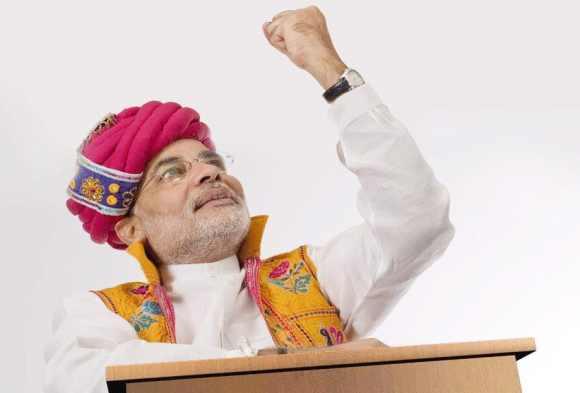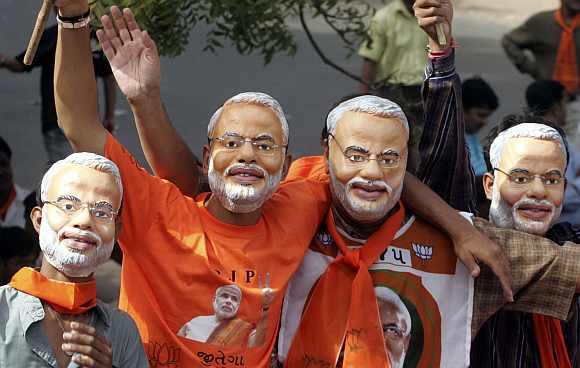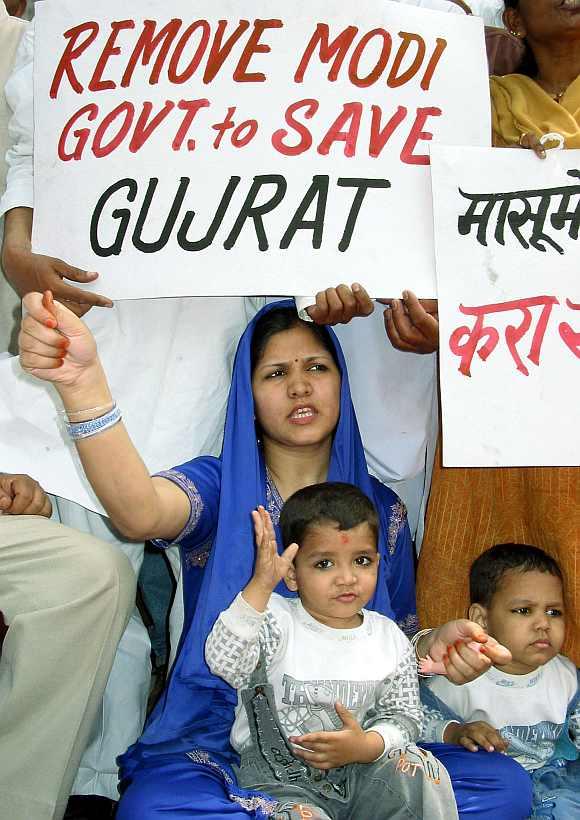
It's been 10 years since the Godhra carnage and Narendra Modi is still around and divisive. Why, precisely, should the world think that the man who presided over India's worst governance failure in decades is somehow a role model for efficiency, asks Mihir S Sharma.
The odd thing is not that, 10 years after the riots he -- at best -- let happen, Narendra Modi is still around and divisive. The odd thing is that he has become iconic -- in the original meaning of the word. He stands for more than what he actually is. He attracts to himself myths.
Last week, the endless arguments founded on those myths were on display: did Modi commit the sin of laziness, or something more mortal? Has he atoned by 10 years in Development Purgatory or not? Or by meritoriously restraining himself from causing any riots since?
The first myth, the most important, perhaps: that people will move on. Slavering Modi-lovers demand, every three seconds or so, "over it yet?" With every minor piece of news from the legal process, every anniversary, we are reminded it was years ago, nothing was proved in court, let it go. Well, here's some news, fan boys: this anger isn't going away.
How could it? Just as an entire American generation was politicised by the Vietnam War, a whole generation of young people here first discovered political evil during the 2002 pogrom. We know others saw it differently -- as cleansing, as revenge, as a lesson. These are the people that worship Modi for the riots, but talk only of his record on roads. We won't let go, because they haven't.
...
For Rediff Realtime News click here

Here's the second myth: that the only justification 2002 ever needs is four other digits. That 1984 somehow means that a mystical riot-creation equivalence exists between Modi and everyone else, so why single out Modi?
Like all arguments for equivalence between horrors, this is never made in good faith. Those making it care little for the horrors or injustices of the anti-Sikh riots of 1984 except when they must defend the deified hero of 2002. 1984's victims aren't living penniless in garbage dumps today as, around them, a state's development is praised.
Those responsible aren't being lauded on TV by anchors and CEOs, smugly accepting overblown compliments as their due. Rajiv Gandhi is dead; Kumar, Bhagat and Tytler aren't exactly being pushed as the next PM. Look hard at the prime minister from the party of 1984, and then tell us again, Moditattvas: where is this equivalence you speak of, except in your hopeful imaginings?

The third myth: the whole Vikas Purush thing. Sorry, you can't have it both ways, Modi-roadies: if you deny Narendrabhai's sins of omission or commission caused Muslims to die, you're left with the conclusion that he's laughably incompetent. Why, precisely, should the world think that the man who presided over India's worst governance failure in decades is somehow a role model for efficiency?
We suspect that a man who isn't telling the truth about what he did during the riots will be similarly unreliable about how much investment his state is getting, or its record on malnutrition and infant mortality. We don't think of his vikas persona and his Hindu vengeance persona as distinct. We think they're the same person. And we know that person cannot be trusted.
Oh, we know you like to talk about his economic successes, by which you mostly mean the number of investors with whom he's had photo-ops. Frankly, the rest of us suspect that Gujarat's natural advantages are such that you could put Mamata Banerjee in charge and it would still attract investment.

That takes us to the fourth myth, one we tell ourselves: that anger at Modi is just about Modi. It's not. It is also anger at the vileness of the arguments Modi-toadies employ. And futile anger at the voters of his state who vote him back in constantly, agreeing that attacks on Modi are in fact on Gujarat, too. Apparently, just as he has taken credit for Gujarat's successes, he takes the plaudits for Gujarat's failures.
Some of us deluded, foolish liberals may like to imagine that the land of Gandhi has a Disney-esque history of people living happily together. But many know of the sultanate's bloody history, of the divisions that spilled over from Ahmedabad's working class into its geography a century ago.
And all of us have met people from there who are a little more strident on the subject of foreigners, invaders and vote banks than we're accustomed to. Modi's defenders are right about one thing: if riots are to happen somewhere, they'll happen in his state. So, yes, we too are guilty of focusing anger on one individual.

But that individual, after all, has campaigned on how talking about the riots is like stabbing Gujarati pride. He has never expressed remorse or responsibility. He has, instead, played a deep double game -- denying everything to the courts, going nudge-nudge-wink-wink-say-no-more to his voters.
Again, the biggest reason that many of us will never like Modi is that the people who like him today actually like him because they think he allowed and defended the riots.
So, how to stay sane in the season of Modi the Ubiquitous, Modi the Iconic? Try his personal website, narendramodi.in. It's like vaccination: you're cured by a total Modi overdose. Modi pumping his fist in the air theatrically, Modi in an ill-fitting meet-the-Westerners suit, Modi doing yoga in designer saffron -- all with his two stock expressions, the bad-tempered half-smile and the solemn "thinking" expression, like Governance on a monument.
Once vaccinated, you can't think of him as anything but a pompous, self-regarding politico with bad grammar and a touch of megalomania. Replace Modi the Myth with Modi the Man, and you discover that no myth can survive laughter.